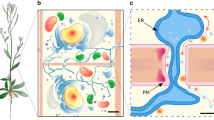Summary
Investigations into plant intercellular communication were initiated through an examination of plasmodesmata and cell-to-cell passage of molecular probes in the staminal hairs ofSetcreasea purpurea. Plasmodesmata connecting staminal hair cells of small buds are filled with an electron-opaque homogenous material. To examine the permeation selectivity of plasmodesmata, molecular probes made up of fluorescein isothiocyanate (FITC) complexed with amino acids and peptides were injected into the staminal hair cells and the spread of these fluorescent molecules through the symplast, was monitored. Molecules composed of FITC complexed to single amino acids with polar and aliphatic R groups travel rapidly, while those which include peptides travel slowly. Dye molecules composed of an amino acid with an aromatic side group do not pass from cell to cell at all. It is hypothesized that the material occluding the plasmodesmata constitutes the diffusion barrier, by presenting a hydrophilic environment which allows passage of molecules with maximum molecular weights of 700–800 daltons, but which retains those with aromatic side groups.
Similar content being viewed by others
References
De Mello, W. C., 1977: Intercellular Communication (De Mello, W. C., Walmor, C., eds.). New York: Plenum Press.
Evans, W. H., 1980: Communication between cells. Nature283, 521–522.
Furshpan, E. J., Potter, D. D., 1968: Low resistance junctions between cells in embryos and tissue culture. Curr. Topics Devel. Biol.3, 95–127.
Glauert, A. M., 1975: Fixation, dehydration and embedding of biological specimens. In: Practical Methods in Electron Microscopy (Glauert, A. M., ed.), pp. 37, 41. New York: American Elsevier Pub. Co.
Goodwin, P. B., 1976: Physiological and electrophysiological evidence for intercellular communication in plant symplasts. In: Intercellular Communication in Plants: Studies on Plasmodesmata (Gunning, B. E. S., Robards, A. W., eds.), pp. 121–129. New York: Springer.
- 1981: Short distance transport in the plant symplast. XIII. International Botanical Congress. Abstracts p. 35.
Karnovsky, M. J., 1965: A formaldehyde-glutaraldehyde fixative of high osmolality for use in electron microscopy. J. Cell Biol.27, 137 A.
Loewenstein, W. R., 1968: Some reflections on growth and differentiation. Perspectives in Biol. and Med.11, 260–272.
- 1977: Membrane Channels-intro remarks Symposium. Amer. Physio. Soc.
—, 1979: Junctional intercellular communication and the control of growth. Biochim. biophys. Acta560, 1–65.
Mericle, L. W., Hazard, R. M., 1980: Stamen hair initiation and development inTradescantia, clone 02. Environ. exp. Bot.20, 233–241.
Mogensen, H. L., 1981: Translocation of uranin within the living ovules of selected species. Amer. J. Bot.68, 195–199.
Robards, A. W., 1976: Plasmodesmata in higher plants. In: Intercellular Communication in Plants: Studies on Plasmodesmata (Gunning, B. E. S., Robards, A. W., eds.), pp. 15–57. New York: Springer.
Roelofsen, P. A., Houwink, A. L., 1951: Cell wall structure of staminal hairs ofTradescantia virginica and its relation with growth. Protoplasma50, 1–22.
Rose, B., Simpson, I., Loewenstein, W. R., 1977: Ca+2 ion produces graded changes in permeability of membrane channels in cell junction. Nature267, 625–627.
Sato, T., 1968: A modified method for lead staining of thin sections. J. Electron Microsc.17, 158–159.
Schwarzmann, G., Wiegandt, H., Rose, B., Zimmarman, A., Ben-Haim, D., Loewenstein, W. R., 1981: Diameter of the cell-to-cell junction membrane channels as probed with neutral molecules. Science213, 551–553.
Simpson, I., 1978: Labeling of small molecules with fluorescein. Analytical Biochem.89, 304–305.
—,Rose, B., Loewenstein, W. R., 1977: Size limit of molecules permeating the junctional membrane channels. Science195, 294–296.
Spanswick, R., 1972: Electrical coupling between cells of higher plants: A direct demonstration of intercellular communication. Planta102, 215–227.
—,Costerton, J., 1967: Plasmodesmata inNitella translucens: Structure and electrical resistance. J. Cell Sci.2, 451–464.
Spurr, A. R., 1969: A low-viscosity epoxy resin embedding medium for electron microscopy. J. Ultrastruct. Res.26, 31–43.
Tyree, M. T., Tammes, P. M. L., 1975: Translocation of uranin in the symplasm of staminal hairs ofTradescantia. Can. J. Bot.53, 2038–2046.
Van Iterson, G., 1937: A few observations on the hairs of the stamens ofTradescantia virginica. Protoplasma27, 190–211.
Van Went, J. L., Van Aelst, A. C., Tammes, P. M. L., 1975: Anatomy of staminal hairs fromTradescantia as a background for translocation studies. Acta. Bot. Neerl.24, 1–6.
Author information
Authors and Affiliations
Rights and permissions
About this article
Cite this article
Tucker, E.B. Translocation in the staminal hairs ofSetcreasea purpurea . Protoplasma 113, 193–201 (1982). https://doi.org/10.1007/BF01280907
Received:
Accepted:
Issue Date:
DOI: https://doi.org/10.1007/BF01280907




